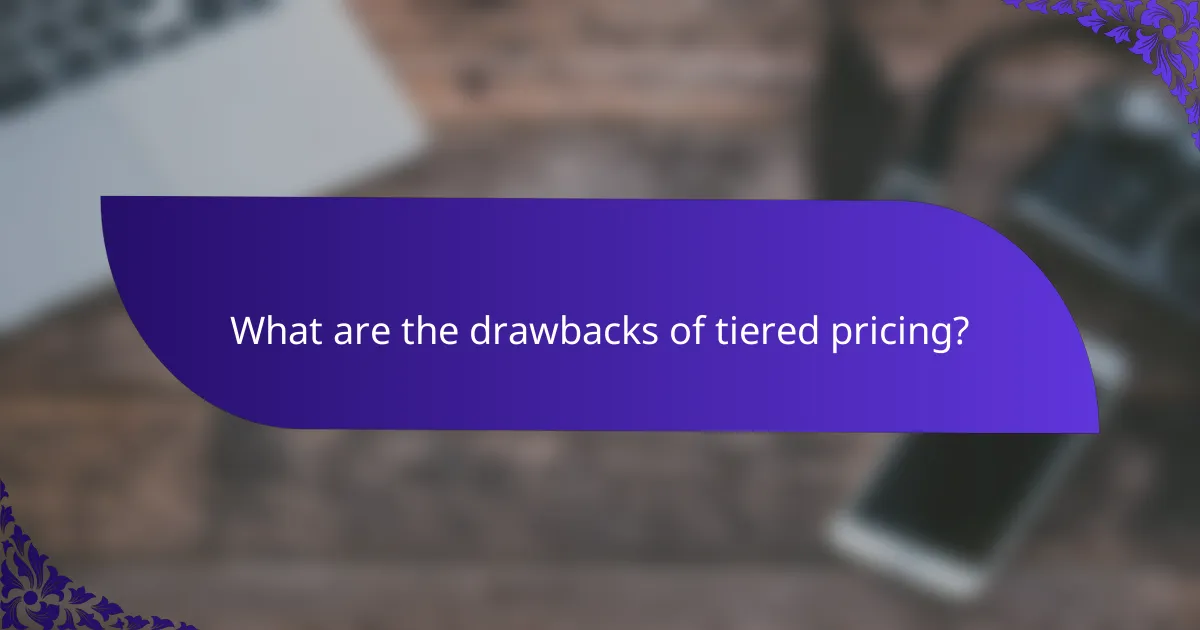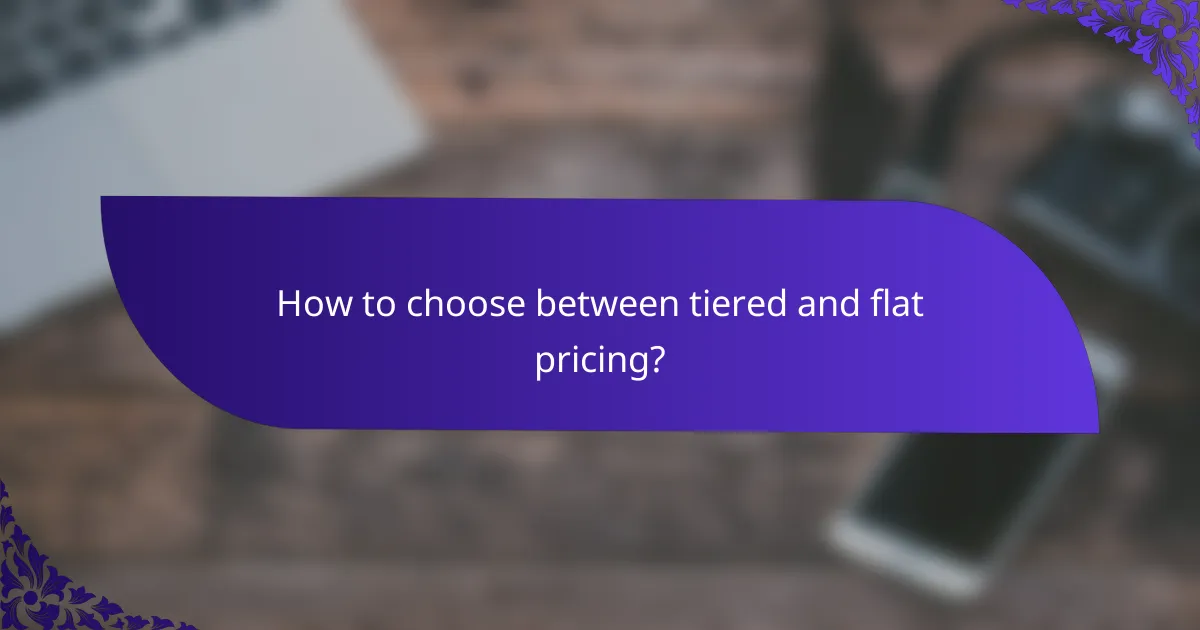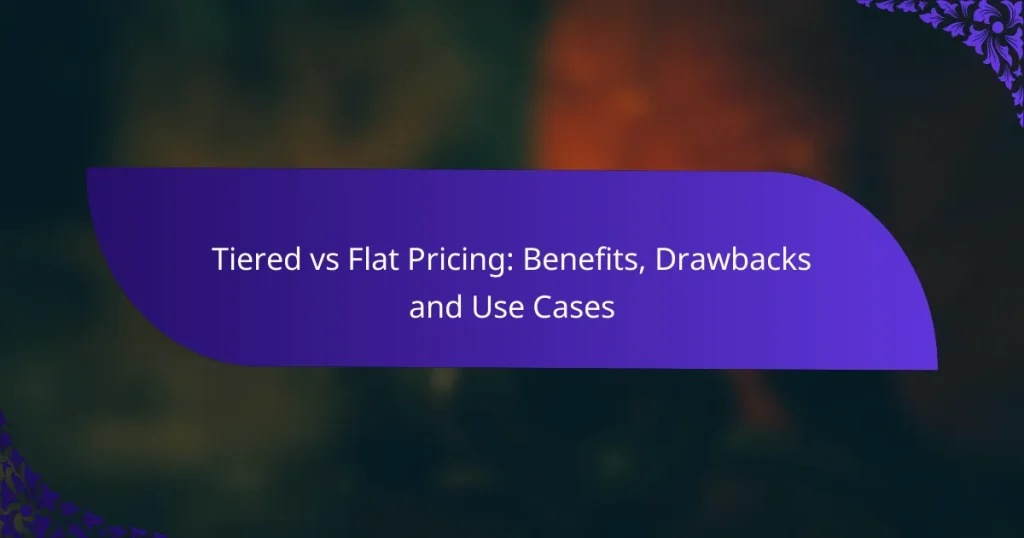When choosing a pricing strategy, businesses often weigh the benefits and drawbacks of tiered versus flat pricing models. Tiered pricing allows for flexibility and can attract diverse customer segments, but it may complicate the purchasing process. In contrast, flat pricing offers simplicity and transparency, making it easier for customers to understand costs upfront. Each model has its unique use cases, depending on the target market and business objectives.

What are the benefits of tiered pricing?
Tiered pricing offers several advantages, including the ability to cater to different customer segments and maximize revenue potential. By structuring prices in tiers, businesses can appeal to a wider audience while encouraging customers to spend more based on their needs.
Increased customer segmentation
Tiered pricing allows businesses to effectively segment their customer base by offering different price points for varying levels of service or product features. This segmentation helps identify and target specific groups, ensuring that each segment finds value in the offerings. For example, a software company might provide basic, standard, and premium plans tailored to different user needs.
Higher revenue potential
With tiered pricing, companies can tap into higher revenue potential by encouraging customers to choose higher-priced tiers that offer additional features or benefits. This strategy can lead to increased average transaction values, as customers may opt for more expensive options when they see the added value. Businesses often experience revenue growth in the range of 10-30% after implementing tiered pricing structures.
Flexibility in pricing
Tiered pricing provides flexibility, allowing businesses to adjust their offerings based on market demand or customer feedback. Companies can easily modify the tiers, add new features, or change pricing to stay competitive. This adaptability helps businesses respond to changing market conditions and customer preferences effectively.
Encourages upselling
By presenting multiple pricing tiers, tiered pricing naturally encourages upselling. Customers are more likely to consider upgrading to a higher tier when they see the benefits and features associated with it. For instance, a subscription service might highlight exclusive content available only in the premium tier, prompting users to upgrade for enhanced experiences.
Attracts diverse customer base
Tiered pricing attracts a diverse customer base by catering to various budgets and preferences. It allows customers to choose a plan that best fits their financial situation, from budget-conscious individuals to those willing to pay more for premium features. This inclusivity can significantly expand a business’s market reach and customer loyalty.

What are the drawbacks of tiered pricing?
Tiered pricing can complicate the purchasing process and may deter some customers. While it offers flexibility, it also introduces several potential drawbacks that businesses should consider.
Complexity in pricing structure
Tiered pricing structures can become complex, making it difficult for customers to understand what they are paying for. When multiple tiers exist, each with different features and prices, customers may struggle to determine which option best meets their needs. This complexity can lead to decision fatigue, causing potential buyers to abandon their purchase.
To mitigate this issue, businesses should aim for clarity in their pricing tiers. Simplifying the number of tiers or clearly outlining the benefits of each can help customers make informed choices without feeling overwhelmed.
Potential customer confusion
Customers may find tiered pricing confusing, especially if the differences between tiers are not clearly communicated. If potential buyers are unsure about what they will receive at each level, they may hesitate to commit to a purchase. This confusion can lead to frustration and ultimately result in lost sales.
To address this, companies should provide straightforward comparisons and visual aids, such as charts or tables, that highlight the differences between tiers. Clear labeling and descriptions can significantly enhance customer understanding.
Risk of alienating budget-conscious customers
Tiered pricing can alienate budget-conscious customers who may feel that the lowest tier does not offer sufficient value. If the entry-level option is too limited, these customers might look elsewhere for more affordable solutions. This can be particularly detrimental in competitive markets where price sensitivity is high.
To avoid losing this segment, businesses should ensure that the lowest tier provides essential features at a reasonable price. Offering a well-rounded basic package can help attract and retain budget-conscious customers.
Higher administrative costs
Implementing a tiered pricing model can lead to higher administrative costs due to the need for ongoing management and analysis. Businesses must regularly assess the performance of each tier and adjust pricing or features accordingly, which can require significant resources. Additionally, customer service teams may face increased inquiries related to tier differences.
To manage these costs, companies should invest in automated tools that track sales and customer feedback for each tier. This can streamline the process and reduce the manual workload associated with maintaining a tiered pricing structure.

What are the benefits of flat pricing?
Flat pricing offers a straightforward approach where customers pay a single, fixed fee for a product or service. This model simplifies transactions and enhances customer satisfaction by eliminating hidden costs.
Simplicity and transparency
Flat pricing is inherently simple, making it easy for customers to understand what they are paying for. There are no complicated calculations or unexpected fees, which fosters trust and encourages purchases.
This transparency can lead to higher customer retention, as clients appreciate knowing exactly what to expect from their financial commitments.
Ease of understanding for customers
Customers find flat pricing intuitive, as they can quickly assess the value of a product or service without delving into complex pricing structures. This clarity can be particularly beneficial in competitive markets where consumers compare options.
For example, a subscription service that charges a flat monthly fee allows customers to budget easily, enhancing their overall experience and satisfaction.
Lower administrative overhead
Flat pricing reduces administrative burdens associated with billing and invoicing. Companies can streamline their operations by eliminating the need for detailed usage tracking or tier calculations.
This efficiency can result in cost savings, allowing businesses to allocate resources to other areas, such as customer service or product development.
Predictable revenue stream
Flat pricing creates a predictable revenue stream, which can be advantageous for budgeting and financial planning. Businesses can forecast income more accurately, aiding in strategic decision-making.
For instance, a gym that charges a flat monthly membership fee can anticipate its cash flow, making it easier to manage expenses and investments in facilities or services.

What are the drawbacks of flat pricing?
Flat pricing can limit a business’s ability to maximize revenue and adapt to customer needs. While it offers simplicity, it often fails to account for varying customer demands and market conditions.
Limited revenue growth potential
Flat pricing structures can restrict revenue growth because they do not scale with customer usage or demand. Businesses may miss out on higher earnings from customers willing to pay more for additional features or services. For example, a software company might lose potential income by charging all users the same monthly fee, regardless of their usage levels.
To enhance revenue, consider implementing tiered pricing that allows customers to choose plans based on their needs. This approach can lead to increased customer satisfaction and higher overall sales.
Less flexibility for customer needs
Flat pricing often lacks the flexibility to cater to diverse customer requirements. Customers may have varying levels of engagement or need different features, but a single price point does not accommodate these differences. For instance, a small business may find a flat fee too high while a larger enterprise may see it as a bargain.
Offering customizable options or add-ons can provide the necessary flexibility, allowing customers to pay for only what they need. This can lead to better customer retention and loyalty.
Potentially fewer customer segments
Flat pricing can limit the range of customer segments that a business can attract. By offering only one price, companies may alienate potential customers who are looking for more affordable or scalable options. A flat pricing model might appeal primarily to budget-conscious consumers, leaving out those willing to invest more for premium features.
To reach a broader audience, consider adopting a tiered pricing model that includes various price points. This strategy can help capture different market segments, from budget shoppers to premium users, ultimately expanding your customer base.

How to choose between tiered and flat pricing?
Choosing between tiered and flat pricing depends on your business model and customer needs. Tiered pricing offers flexibility and can cater to different usage levels, while flat pricing provides simplicity and predictability.
Assess customer demographics
Understanding your customer demographics is crucial when deciding between tiered and flat pricing. Analyze factors such as age, income, and usage patterns to determine which pricing model aligns best with your target audience.
For instance, if your customers are primarily budget-conscious individuals, a flat pricing model may be more appealing due to its straightforwardness. Conversely, if your customer base includes businesses with varying needs, tiered pricing can accommodate different consumption levels and maximize revenue.
Consider conducting surveys or analyzing purchase data to gather insights. This information will help you tailor your pricing strategy effectively, ensuring it resonates with your customers’ preferences and behaviors.


